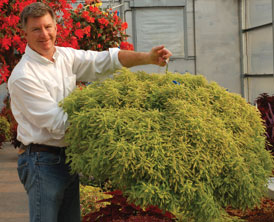4/28/2014
Picking the Perfect Plant
Chuck Pavlich

Terra Nova has long been recognized as the company that popularized the genus heuchera, but we’re so much more now. Annuals, perennials and shrubs fill our catalogs with color, innovation and must-have plants. Our selection process is exhausting, but rewarding.
Pictured: When the team at Terra Nova Nurseries began working toward a better agastache, they decided they wanted to focus on three key elements: shorter, hardier and more disease resistance. The result is Agastache Kudos.
When we start the selection process for a possible introduction, we do what any consumer would: look for a plant that is appealing visually. From there, we put careful consideration into each step of the way, guiding a product through trials and tests, evaluations and through our very opinionated selection team.
In the case of our Kudos Agastache series, our breeding team thought about what could be done to improve existing lines of agastaches. We thought: shorter would be nice, hardier, too, and of course, can we do anything about the lack of disease resistance?
The next year, we started a process to achieve our goals. I knew of a species that grew in high deserts under poor conditions, and while on a hike, I collected seeds of this weedy, measly, sprawling plant and brought them to Terra Nova. The first year it bloomed, I have to say that the breeder, Janet Egger, gave me a look, that if I had to sum it up in two words, it could not be published.
Janet worked with it, and over a fair number of generations, we selected some game-changing plants. I felt that simply dwarfing, well-colored agastaches would be great, but we bred so much more into these plants that the outcome was better than we anticipated. After we made our selections, (five or six generations down the road) we kept the parents planted around to ensure the genetic lines would not be lost.
After several winters where we had temperatures in the single digits, combined with our chronically wet Oregon clay soil, we felt we had made an improvement in this genus. Summers here in Oregon are lovely, but early summer rains bring on nasty infections of Downy Mildew. Most all agastaches showed mildew at some time. Our new Kudos exhibited no infection when the pathogen was present. Super clean!
The tidy habits of Kudos, combined with increased hardiness and disease resistance, make this breeding some of Terra Nova’s best to date.
Our selection process, past the “this is amazing” stage, goes as follows:
In year one, plants are selected and nominated to “prestart” status. Apical buds are removed from the mother plants, put into our lab and screened for about 30 viruses and pathogens. This lab start is multiplied and trialed for good lab multiplication rates.
Year two, our production trials start. Because we’re vertically integrated—meaning we control every process of the product until it goes out our door—we can combine years of testing. Early in the spring, after the lab initiation year, we bring out a number of plants for “true to type” and container and ground trials. If the plant could be grown in sun and shade, both locations are trialed, also. While these trials are going on, our liner production facility is receiving trial batches from the lab. Even though we may be familiar with the genus, we still trial every variety and tweak things as they progress.
Throughout the spring, summer and fall, our team meets on a weekly basis to discuss each crop. They’re judged on uniformity, appeal and health longevity. Some are dismissed early; some may be backed up another year due to uneven trial results. The majority move through smoothly and the best get moved to the naming committee and production/introduction list. Once we’ve decided upon a name, we can schedule the plant to be trialed at facilities other than our own. Due to recent changes in the patent laws, we’re not comfortable without a patent being written on plants prior to external trialing. It used to be we had one year from date of introduction to file the patent; now it’s the first-to-file rule. Whoever submits the patent first owns the plant.
This last year, our Kudos were trialed in several locations and when I saw them at Raker’s trials, I knew we had a home run. The colors were vivid and the habit was tidy, despite summer rains.
As a breeding company, we’ve grown in size and matured in our methods; what we offer is a better plant for everyone that comes in contact with it. For the grower/wholesaler, we breed plants that require little-to-no PGRs and breed for better disease resistance. For the retailer, our products have a longer shelf life, have more multi-season features and require less upkeep. For the end consumer, the voice we listen to the most, we offer beauty, durability and value.
GP
Chuck Pavlich is the director of new products and development at Terra Nova Nurseries. He’s responsible for new ideas for the breeders, as well as overseeing the breeding process and shepherding the company’s new products to the world perennial market. He can be reached at chuck@terranovanurseries.com.